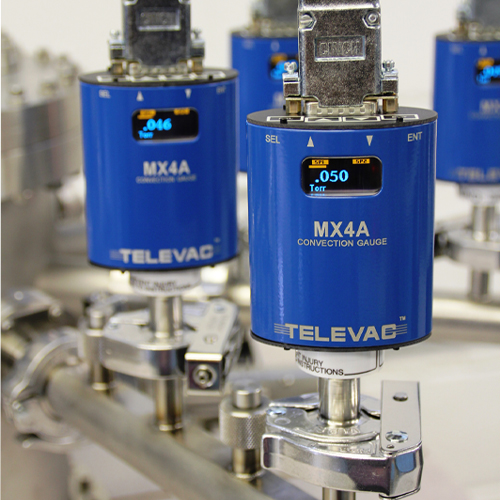Vacuum Calibration Services

Quick Reference Table
| Description | Factory | NIST Traceable | ISO 17025 Accredited |
| Electrical verification | Yes | No | No |
| Vacuum comparison calibration to NIST traceable references | No | Yes | Yes |
| Reference standard uncertainties included | No | No | Yes |
| ISO 17025 accredited calibration | No | No | Yes |
Submit a Calibration Request
Options for Calibrations
1. ISO 17025 calibration: The Fredericks Company is ISO/IEC 17025 accredited for vacuum and pressure calibration in the range of 1E-6 Torr to 1000 Torr. Units are calibrated (on a vacuum stand) in nitrogen gas at various points (gauge dependent) against reference standards traceable to NIST, using systems that are accredited to ISO 17025. This includes incoming (as found) data, outgoing (as left) data after calibration adjustments, and the reference standard uncertainty at each calibration point. A statement of conformity using a simple decision rule is included. The conformity decision is made by comparing the measurement results to the calibration limits, defined by the form downloadable here Televac® Calibration Tolerances, without including measurement uncertainty.
2. NIST traceable calibration: The Fredericks Company offers NIST traceable calibration, where units are calibrated (on a vacuum stand) in nitrogen gas at various points (gauge dependent) against reference standards traceable to NIST. This includes incoming (as found) data, outgoing (as left) data after calibration adjustments, but does not include the reference uncertainty at each point (ISO 17025 accredited calibration does include uncertainties).
3. Factory (previously called “standard”) calibration: The Fredericks Company offers factory calibration, where units are electrically verified using electrical equipment only. The verification includes checking that the units provide vacuum readings within a specified tolerance when a specific electrical signal is applied. This is not a vacuum calibration, and does not guarantee that a sensor will read accurately when connected to a controller or active gauge. This is because sensor contamination and sensor to sensor mechanical variability cannot be accounted for with an electrical verification.
Calibration Points
Default calibration points can be found on our Televac® Calibration Tolerances page. Additional points can be ordered for ISO 17025 accredited and NIST traceable calibrations, and are an additional charge per point. Additional points must be included on your service order request form, they must be shown on our order acknowledgement, and they must be included on your purchase order (if applicable).
Part Numbers
| Part Number | Description |
| 17025-CAL-1 | Default calibration points for controller and gauge combinations as shown on Televac® Calibration Tolerances, quantity 1 per gauge calibrated |
| 17025-CAL-1-N | The same as 17025-CAL-1, but at a reduced price for a new controller or active gauge |
| 17025-CAL-XPT | If a point isn’t shown on Televac® Calibration Tolerances, there’s a per point charge for extra points that’s assigned this part number |
| NIST-CAL-1 | Default calibration points for controller and gauge combinations as shown on Televac® Calibration Tolerances, quantity 1 per gauge calibrated |
| NIST-CAL-1-N | The same as 17025-CAL-1, but at a reduced price for a new controller or active gauge |
| NIST-CAL-XPT | If a point isn’t shown on Televac® Calibration Tolerances, there’s a per point charge for extra points that’s assigned this part number |
| FACT-CAL-1 | Default factory (electrical test) calibration points for controller and gauge combinations as shown on Televac® Calibration Tolerances, quantity 1 per channel or gauge calibrated |
Recommended Calibration Intervals
The recommended calibration interval (how often you send your equipment in for calibration) for any type of vacuum calibration is entirely dependent on your specific requirements and quality systems. For example, your facility may adhere to specific standards that require quarterly, semi-annual, or yearly calibrations of vacuum measurement equipment. Or you might expose your vacuum gauges to heavy contamination and you just want to feel confident in the readings. Our default recommendation is a 1 year calibration interval, which will be listed on your calibration certificate and the equipment’s calibration sticker, unless a different interval is requested.
ISO 17025 Calibration in More Detail
ISO 17025 calibrations can only be done with electronics like our MX200, MX200 EthernetIP, MX200 PROFINET, MM200, MC300, MV2A, Compact 2A, VacuGuard™, or B2A vacuum controllers or MX2A Thermocouple, MX4A Convection, MX7B Cold Cathode, MX7M Cold Cathode, or CC-10 Wide-Range active gauges.
For vacuum controllers, all gauges (sensors) and cables that you’d like calibrated must be returned as a set or purchased new. For active gauges, the cables do not need to be included. For returns, each system will get a unique return number (service order number or RMA number) which can be used to track the system for the return and while it’s at our facility. ISO 17025 accredited calibration pricing is on a per gauge basis, with no distinction in the pricing or order process for the type of controller or gauge.
For example, if you return an MX200 that has 3 gauges that you’d like calibrated, you would order quantity 3 of calibration part number 17025-CAL-1. Similarly, if you needed calibration for an MX4A, you would order quantity 1 of 17025-CAL-1. For ISO 17025 accredited calibrations, calibration options cannot be mixed. For example, if you had an MX200 with 3 channels (stations) you can’t have 2 channels with 17025 calibration and 1 channel with NIST traceable or factory calibration. ISO 17025 accredited calibration certificates can be provided digitally as well as paper copies in the return shipment. ISO 17025 accredited calibration is also available for new systems with the same per gauge approach but at a reduced cost.
NIST Traceable Calibrations in More Detail
NIST traceable calibrations can only be done with electronics like our MX200, MX200 EthernetIP, MX200 PROFINET, MM200, MC300, MV2A, Compact 2A, VacuGuard™, or B2A vacuum controllers or MX2A Thermocouple, MX4A Convection, MX7B Cold Cathode, MX7M Cold Cathode, or CC-10 Wide-Range active gauges. For vacuum controllers, all gauges (sensors) and cables that you’d like calibrated must be returned as a set or purchased new. For active gauges, the cables do not need to be included.
For returns, each system will get a unique return number (service order number or RMA number), which can be used to track the system for the return while it’s at our facility. NIST traceable calibration pricing is on a per gauge basis, with no distinction in the pricing or ordering process for the type of controller or gauge.
For example, if you return an MX200 that has 3 gauges that you’d like calibrated, you would order quantity 3 of calibration part number NIST-CAL-1. Similarly, if you needed calibration for an MX4A, you would order quantity 1 of 17025-CAL-1. For NIST traceable calibrations of multi-channel controllers (MX200, MM200, MC300), calibration options can be mixed with factory calibrations. For example, if you had an MX200 with 3 channels (stations) you can have 2 channels with NIST traceable calibration and 1 channel with factory calibration, or any mix that fits your requirements.
NIST traceable calibration certificates can be provided digitally and as paper copies in the return shipment. NIST traceable calibration is also available for new systems with the same per gauge approach, but at a reduced cost.
Factory Calibrations in More Detail
Note that factory calibrations are an electrical verification using electrical equipment only (no vacuum comparison). Factory calibrations can only be done with electronics like our MX200, MX200 EthernetIP, MX200 PROFINET, MM200, MC300, MV2A, Compact 2A, VacuGuard™, or B2A vacuum controllers or MX2A Thermocouple, MX4A Convection, MX7B Cold Cathode, MX7M Cold Cathode, or CC-10 Wide Range active gauges. For vacuum controllers and active gauges, the gauges (sensors) and cables do not need to be included.
Each system will get a unique return number (service order number or RMA number) which can be used to track the system for the return and while it’s at our facility. Factory calibration pricing is on a per gauge basis, with no distinction in the pricing or order process for the type of controller or gauge.
For example, if you return an MX200 that has channels that you’d like calibrated, you would order quantity 3 of calibration part number FACT-CAL-1. Similarly, if you needed calibration for an MX4A, you would order quantity 1 of FACT-CAL-1. For factory calibrations of multi-channel controllers (MX200, MM200, MC300), NIST traceable calibration can be done on the same return as a NIST traceable calibration (but not an ISO 17025 accredited calibration). For example, if you had an MX200 with 3 channels (stations) you can have 2 channels with NIST traceable calibration and 1 channel with factory calibration, or any mix that fits your requirements.
Factory calibration certificates can be provided digitally and as paper copies in the return shipment. Factory calibration is included in the cost of new units, so there is no additional charge.
Vacuum Calibration Services
We offer comprehensive vacuum calibration services for all our vacuum gauging equipment, including various calibration options to suit your specific needs. Our calibration services encompass both factory vacuum calibration and NIST traceable vacuum calibration, as well as ISO 17025 Accredited calibrations for all our active gauges and controllers, complemented by passive gauges. Notably, our calibration services are known for their efficiency, with significantly shorter lead times than competitors. Upon receiving your equipment, our turnaround times typically range from 1 to 2 weeks, and expedited services are also available for those with more urgent requirements. Additionally, if you encounter any issues with your vacuum equipment, we offer the convenience of sending it back to us for evaluation and necessary repairs and service. This comprehensive approach underscores our commitment to providing top-quality calibration services tailored to your specific industry and application needs.









